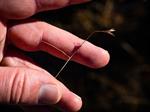Click the number at the start of a key lead to highlight both that lead and its corresponding lead. Click again to show only the two highlighted leads. Click a third time to return to the full key with the selected leads still highlighted.
1 Bristles 8-25, retrorsely barbed distally, antrorsely barbed proximally; spikelets white, turning tan with age. |
..2 Spikelets with 2-3 florets; bristles 8-12; achene 1.6-2.1 mm long, 0.9-1.3 mm wide |
..2 Spikelets with 1 floret; bristles 16-25; achene 2.0-2.4 mm long, 1.3-1.5 mm wide |
1 Bristles 6 or fewer, either retrorsely or (rarely) antrorsely barbed their entire length; spikelets variously brown, rufous, or tan (or very rarely white). |
....3 Spikelets 1-fruited, the solitary achene terminating the axis; clusters 1-7, globose to turbinate. |
......4 Achene body 1.3-2.0 mm long, 0.8-1.1 mm wide; tubercle 0.9-1.8 mm long. |
........5 Clusters turbinate to hemispheric (rarely subglobose), the lowest spikelets usually spreading-ascending to spreading; larger leaves usually < 2 mm wide; achene 1.5-2.0 mm long; tubercle 1.0-1.6 mm long |
........5 Clusters globose to subhemispheric, the lowest spikelets usually reflexed; larger leaves usually > 2 mm wide; achene 1.3-1.9 mm long; tubercle 0.9-1.8 mm long |
......4 Achene body 1.7-2.4 mm long, 1.1-1.8 mm wide; tubercle 1.4-2.7 mm long. |
..........6 Clusters 7-14, turbinate; achene 1.9-2.1 mm long, 1.1-1.2 mm wide; tubercle 2.3-2.7 mm long, exceeding body length |
..........6 Clusters 1-7, globose to hemispheric; achene 1.8-2.6 mm long, 1.1-1.8 mm wide; tubercle 1.4-2.4 mm long, shorter than to equaling body length. |
............ 7 Achene 1.1-1.2 mm wide, 1.7-1.9 long; tubercle 1.4-1.8 mm long; heads hemispheric |
............ 7 Achene 1.4-1.6 mm wide, 2.0-2.4 mm long; tubercle to 2.4 mm long; heads globular |
....3 Spikelets 1-5 fruited (if 1-fruited, then the axis terminated by a sterile floret); clusters 2-many, ovoid to turbinate (rarely globose). |
............ ..8 Clusters numerous, usually 20 or more; tubercle 1.3-1.8 mm long; achene 0.9-1.5 mm wide, 1.5-2.0 mm long, the summit narrowly truncate, the faces umbonate, the margin thickened and wire-like; leaves 2.5-7 mm wide. |
............ ....9 Achene face medium brown, body 0.9-1.1 mm wide, the expanded portion above the gynophore 1.0-1.1 mm long, the gynophore slender and long |
............ ....9 Achene face dark brown, body 1.2-1.5 mm wide, the expanded portion above the gynophore 1.3-1.4 mm long, the gynophore thick and short |
............ ..8 Clusters 2-8; tubercle 0.4-1.2 mm long; achene 0.6-1.2 mm wide, 1.1-2.0 mm long, the summit more rounded than truncate, the faces lenticular, a wire-like margin narrow or not evident; leaves 0.2-3.5 mm wide. |
............ ......10 Achene 0.6-0.8 mm wide, 1.1-1.3 mm long; tubercle 0.4-0.6 mm long; bristles more-or-less equaling the achene; [Endemic to NJ and historically also DE] |
............ ......10 Achene 0.8-1.2 mm wide, 1.3-2.0 mm long; tubercle 0.8-1.6 mm long; bristles more-or-less equaling the tubercle; [collectively widespread]. |
............ ........11 Inflorescence typically with 1 terminal and 1 lateral cluster, the clusters ovoid, with 1-10 spikelets each; achene 1.8-2.0 mm long, 0.8-1.0 mm wide, 2-3 × as long as wide; leaves 0.2-0.4 mm wide |
............ ........11 Inflorescence with 1-6 lateral clusters, the clusters turbinate with usually > 10 spikelets; achene 1.3-1.8 mm long, 0.9-1.2 mm wide, 1.5-2 × as long as wide; leaves 1.5-3.5 mm wide. |
............ ..........12 Longer bristles 0.4 mm shorter than to 0.3 mm longer than the tubercle; tubercle 0.9-1.4 (-1.6) mm long, on average 0.69× as long as achene body; glomerules 3-5 (-6), 6-13 mm wide; [widespread in our area] |
............ ..........12 Longer bristles 0.3-1.0 mm longer than the tubercle; tubercle 0.8-1.1 mm long, on average 0.57× as long as achene body; glomerules 4-8, 4-8 mm wide; [of the Coastal Plain] |













